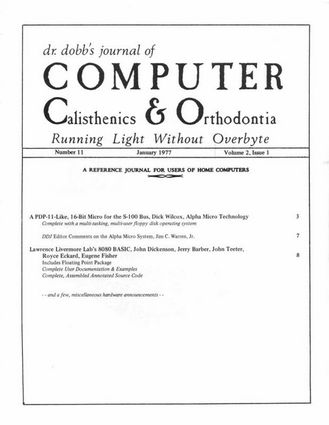
[author : Dick Wilcox, Alpha Micro Technology] #Computer
Extract : « [...] The only feasible solution to this problem seemed to be a totally new design based around some already existing microprocessor. The system I selected is the Western Digital MCP-1600 which is comprised of two system chips (40-pin) and from one to four microprogrammable ROMS (40-pin) which may be custom programmed to perform various macro-level instruction sequences. Working together with a personal friend, Rich Notari, I came up with a workable instruction set that could exist in the MCP-1600. Rich then took this list and added a few frills of his own based on some previous experiences with this particular chip set. A note of thanks is due at this point to him for his undying efforts and late hours for I feel that he is the only programmer I know who could have successfully completed the microprogramming of this system in the short time frame allotted. We have named this particular chip set (4 chips total) as it is currently microprogrammed, the WD-16 microprocessor system. [...] »
[author : Jim C. Warren, Jr.] #Computer
Extract : « [...] Why bother with a multi-tasking operating system on a "personal" computer? Let's daydream for a moment. Wouldn’t it be nice to be able to start a lengthy listing on our hardcopy device; while that was running, start an assembly of a large program; and then go about editing the source for another program from our softcopy terminal? That's exactly what you can do with a multitasking system... the Sixteen/8 (a later name for the CM-16). [...] »
[author : John Dickenson, Jerry Barber, John Teeter, Royce Eckard, Eugene Fisher] #BASIC
Extract : « [...] Abstract
Scientists are finding increased applications for microprocessors as process controllers in their experiments. However, while microprocessors are small and inexpensive, they are difficult to program in machine or assembly language. A highlevel language is needed to enable scientists to develop their own microprocessor programs for their experiments on location. Recognizing this need, LLL contracted to have such a language developed. This report describes the result—the LLL BASIC interpreter.
Introduction
The BASIC interpreter described in this user’s manual was designed to operate with the MCS-8080 microprocessor. It consists of a 5K-byte-PROM resident interpreter used for program generation and debug.
The goal in developing the 8080 BASIC was to provide a high-level, easy-to-use language for performing both control and computation functions in the MCS-8080 microprocessor. To minimize system size and cost, the interpreter was constrained to fit into 5K bytes. It was necessary, therefore, to limit the commands to those considered the most useful in microprocessor applications. [...] »